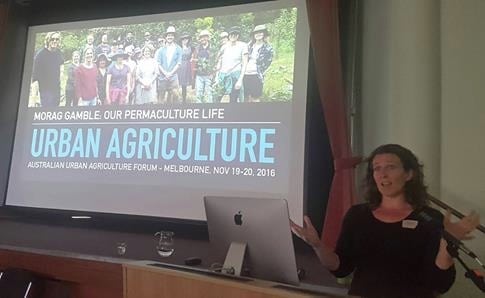 |
| Corridor of green around the old city of Ljubljana, Slovenia where so many people grow their food locally and take surplus to market. |
Many cities are filled with pockets of food – but they could be have so much more. Urban agriculture is a huge topic of exploration.
 |
| I was delighted to offer a one of the mini keynote presentations at the start of the Australian Urban Agriculture Forum in Melbourne last weekend. Photo: Nick Rose: Sustain Australia |
 |
| Cuban farmer explaining how, because of the food and fuel crisis, he moved his farm from a rural village to a kindergarden. Photo: Evan Raymond |
AUSTRALIAN URBAN AGRICULTURE FORUM – October 21-22, 2016
I’ve just returned from 4 days in Melbourne. I am so glad I made the trip to be part of the Australian Urban Agriculture Forum organised by Sustain Australia and The University of Melbourne (Urban Horticulture Program).
I haven’t written for a week because I’ve been so absolutely immersed in preparing, sharing, listening, exploring, chatting. I am now so full of stories and ideas – I’m not actually sure where to start.
I am feeling completely enlivened by the experience and connections made. It was so great to catch up with many old friends, and to meet so many other amazing urban agriculture people from around Australia and the world.
 |
| Photo: Morag Gamble |
CITY AS FARM
One thing I feel sure of is that the notion that cities need to feed themselves must be explored much more holistically and seriously. More than half of humanity lives in urban areas and this figure is rising.
Considering that so much food is already growing in the city areas, I am surprised that such little attention is paid to urban agriculture – limited research, information and support in most places.
Urban agriculture is like a hidden industry, and because of this, despite the incredible benefits it brings, it is under threat particularly in places like Australia. Current forms of urban development continue to gobble up good farming land around all our cities.
There are many other models for developing land that integrate urban agriculture and I’d like to explore examples of these more in future posts.
 |
| Center for Urban Agriculture, California. A remnant farm with encroaching subdivisions that was saved and protected through a landtrust. Photo: Morag Gamble |
I think however things are about to change. Over the past few years there has been a distinct shift in public attitude toward urban food growing.
People and organisations have been lobbying for change globally, and on World Food Day (15 October 2016) the Milan Urban Food Policy Pact was signed by 132 cities.
This represents 460 million inhabitants and urges urban planners everywhere to make food systems central in city planning – to weave food growing into the fabric of the city.
 |
| Rooftop garden at University of Melbourne: Burnley Campus: Photo: Morag Gamble |
- Home kitchen gardens
- Balcony gardens
- Verge gardens
- Rooftop gardens
- Wall gardens
- Permablitz
- City farms
- Community gardens
- Allotments
- Kindergarten and childcare gardens
- School gardens
- University gardens
- Workplace gardens
- Edible landscaping
- Edible street trees
- Community orchards
- Food forests
- Pocket farms
- Horticultural therapy gardens
- Community kitchens
- Seed saving groups
- Social enterprises
- Community cafes
- Food coops
- Food box systems
- Food swaps
- Food banks and food relief
- Food share
- Gleaning
- Community composting
- Food waste reduction
- Farmers markets
- Community supported agriculture
- Market gardens
- Aquaponics and hydroponics
 |
| Community gardens are for all ages. Photo: Morag Gamble |
 |
| Farmers markets directly connect urban consumers and local producers. To have a healthy urban agriculture, we also need to consider different marketing systems. Photo: Morag Gamble |
 |
| Shared chicken flock at Hjortshoj Denmark – an eco-neighbourhood with a farm at the heart of the suburb – a radical, but amazingly common sense idea. |
 |
| Over 20 years ago, we started Northey Street City Farm. Today it continues to be a thriving centre for urban agriculture, and learning about living simply and sustainably in the city. www.nscf.org.au Photo: Morag Gamble |
URBAN AGRICULTURE HELPS FEED THE WORLD
- provide fresh healthy local food
- absorb waste water
- recycle food waste back into the soil
- reduce food miles
- connect people to land
- cultivate community
- support physical and mental wellbeing
- create new green spaces
- achieve greater food security, food sovereignty and food democracy
- strengthen urban resilience
- help alleviate poverty and hunger
- contribute to the ecological integrity of cities and a healthy urban metabolism
- encourage biodiversity
- reduce impact on climate
- improve air quality
- improve the thermal and acoustic comfort of buildings
- and much more …
 |
| Practical permaculture workshops help people to build skills needed to grow food at home. |
HOW MUCH FOOD CAN WE GROW IN THE CITY?
 |
| Image: Foodprint Melbourne |
GET INVOLVED AND SUPPORT URBAN AGRICULTURE PROJECTS
- Grow more food at home, at work, at school, in the community
- Share more of your surplus
- Support more local food systems
- Support the protection of urban and peri-urban farmland
- Australian City Farms and Community Gardens Network – now over 500 projects listed
 |
| Teachers learning how to grow and harvest at the Occidental Arts and Ecology Centre: www.oaec.org Photo: Morag Gamble |


